
Limited Edition Aviation Gallery
Limited Edition
Timothy Paul Smith Photography proudly presents the Limited Edition aviation photography gallery. Inside this gallery is a collection of aviation images I consider my top-shelf work.
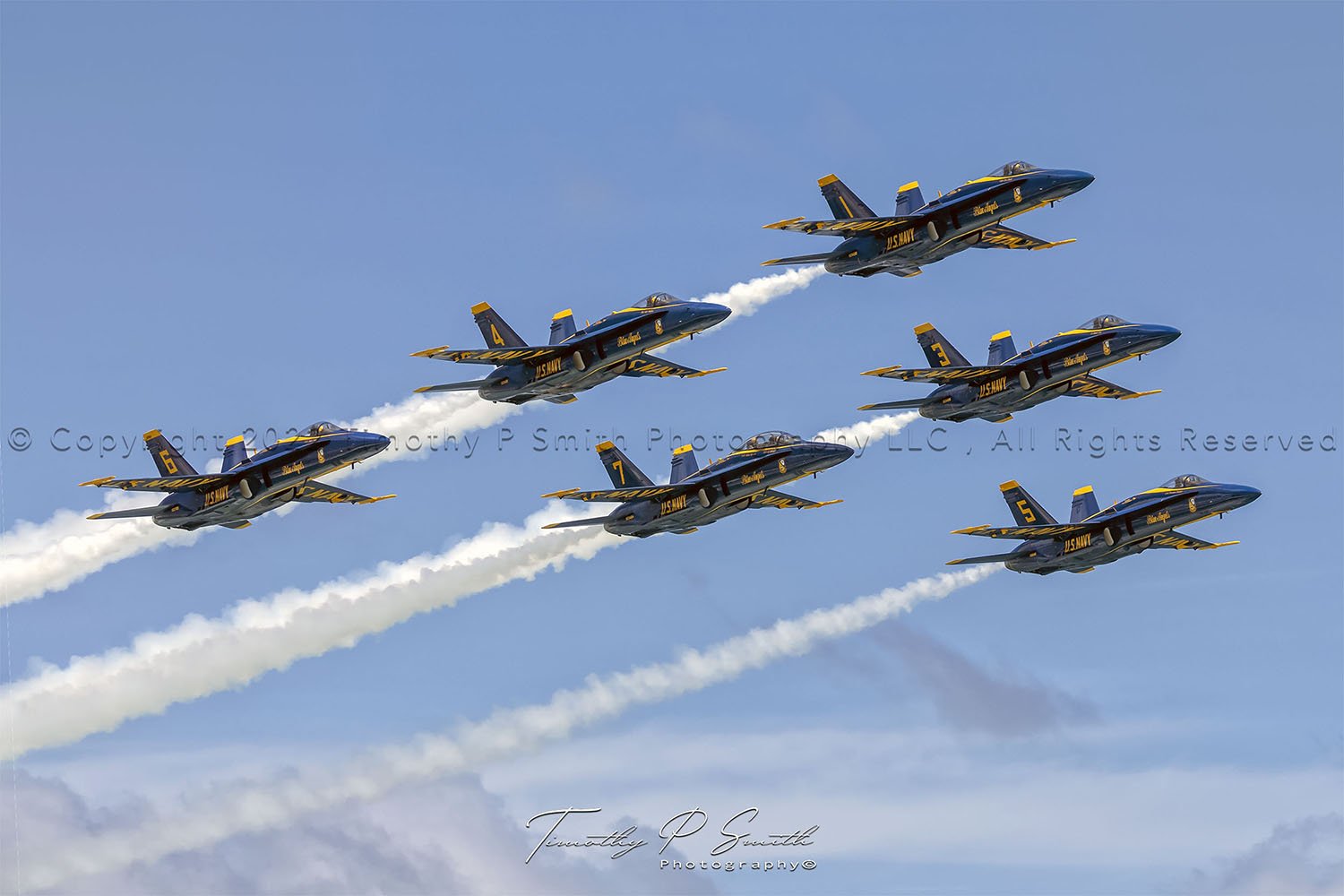

The Delta Blue
Attending and photographing the 2019 Blue Angels Pensacola Beach Week Airshow was a challenge. Lots of rain, lightning and high winds caused by Hurricane Barry off the coast led to most airshow acts canceling their performances. When the Blues made it clear they would not pass on an opportunity to put on an excellent show for the hometown, it lifted everyone’s spirits. Fans cheered all up and down the Pensacola shoreline when the Blues appeared on the horizon. With the team’s appearance, a sense of overwhelming pride and patriotism overcame many on the beach. I found myself with that feeling as well. It was moving to see Pensacola embrace the team like no other town can. For many years now, I have had the pleasure of attending the Pensacola Beach airshow many times. And just like in years past, the Blues gave it their all. This beach airshow is defined by how much each team member would dig in to deliver impressive performance. The 2019 team did just that. The Blue Angel Delta flat pass is one of my favorite formation passes. It is always bittersweet for me because the demonstration is coming to an end. Capturing this image of the Blues’ final pass was an absolute honor. Take notice of each jet's exact spacing and placement as you admire this photo. While not only an alluring formation to photograph, it also has the specific purpose of setting up the Blue Angels’ final maneuver - the carrier landing break. Many fond memories remain from this show. Hard-earned by the team, the fans, and this photographer.
This image was taken during Blue Angel Pensacola Beach week on Thursday, July 11, 2019.
Available only as a Limited Edition. There will be 50 of these images made available for purchase.

Smokin' with the Devil Dog
The North American PBJ-1 is the naval variant of the B-25 Mitchell medium bomber. PBJs arrived in the Pacific Theater in February 1943 and operated with the United States Marine Corps. Squadrons flew from bases across the Philippines, Saipan, Iwo Jima, and Okinawa during the final months of World War II.
On these remote islands, U.S. Marine aircrews were both innovative and resourceful—often modifying their own aircraft to meet combat demands. The PBJ's original glass nose was removed and replaced with a solid nose cone housing eight .50-caliber machine guns, turning the aircraft into a formidable strike platform.
This PBJ-1J, nicknamed “Devil Dog,” bears the proud markings of Marine Corps squadron VMB-612. Ship Number Three from this squadron completed 22 missions before being lost in combat.
In this image, “Devil Dog” flies with her bomb bay doors open, cutting across a column of black pyrotechnic smoke at Wings Over Houston 2018. The dramatic backdrop evokes the wartime conditions her crew once faced and highlights the aircraft’s striking paint scheme and authentic markings.
Captured on Sunday, October 21, 2018, during Wings Over Houston.
“Devil Dog” will be available exclusively as a Limited Edition, with only 50 archival-quality prints released.

Tiger on The Prowl
The Rockwell B-1B Lancer is a long-range, supersonic, swept-wing heavy bomber operated by the United States Air Force. Commonly referred to as the “B-One,” the first B-1Bs entered service in 1986, with nearly 100 airframes delivered by 1988. Since then, the B-1B has seen action in Operation Desert Fox, Afghanistan, and Iraq—and has been continuously deployed in combat operations since 2001.
On Wednesday, February 10, 2020, a flight of two B-1Bs returned to Nellis Air Force Base after a training sortie over the Nevada Test Range. Witnessing not one, but two B-1s in formation entering the landing pattern was an unforgettable sight—especially against the glowing Nevada evening light.
One of the greatest challenges in aviation photography is capturing a single image that tells the story of a unique moment. It requires visualization, planning, precision, and a little luck. For this shot, I positioned myself carefully and anticipated the angle that would place the B-1B between me and the Nevada mountains during final approach. One pass. One opportunity.
Capturing the B-One in flight was a key goal of my trip to Red Flag 20-1. This particular aircraft is from the 37th Bomb Squadron—the “Tigers”—based at Ellsworth Air Force Base, South Dakota. With retirement rumors circling, documenting the Lancer at this moment felt even more vital.
This image was taken on February 10, 2020, at Nellis Air Force Base during Red Flag 20-1.
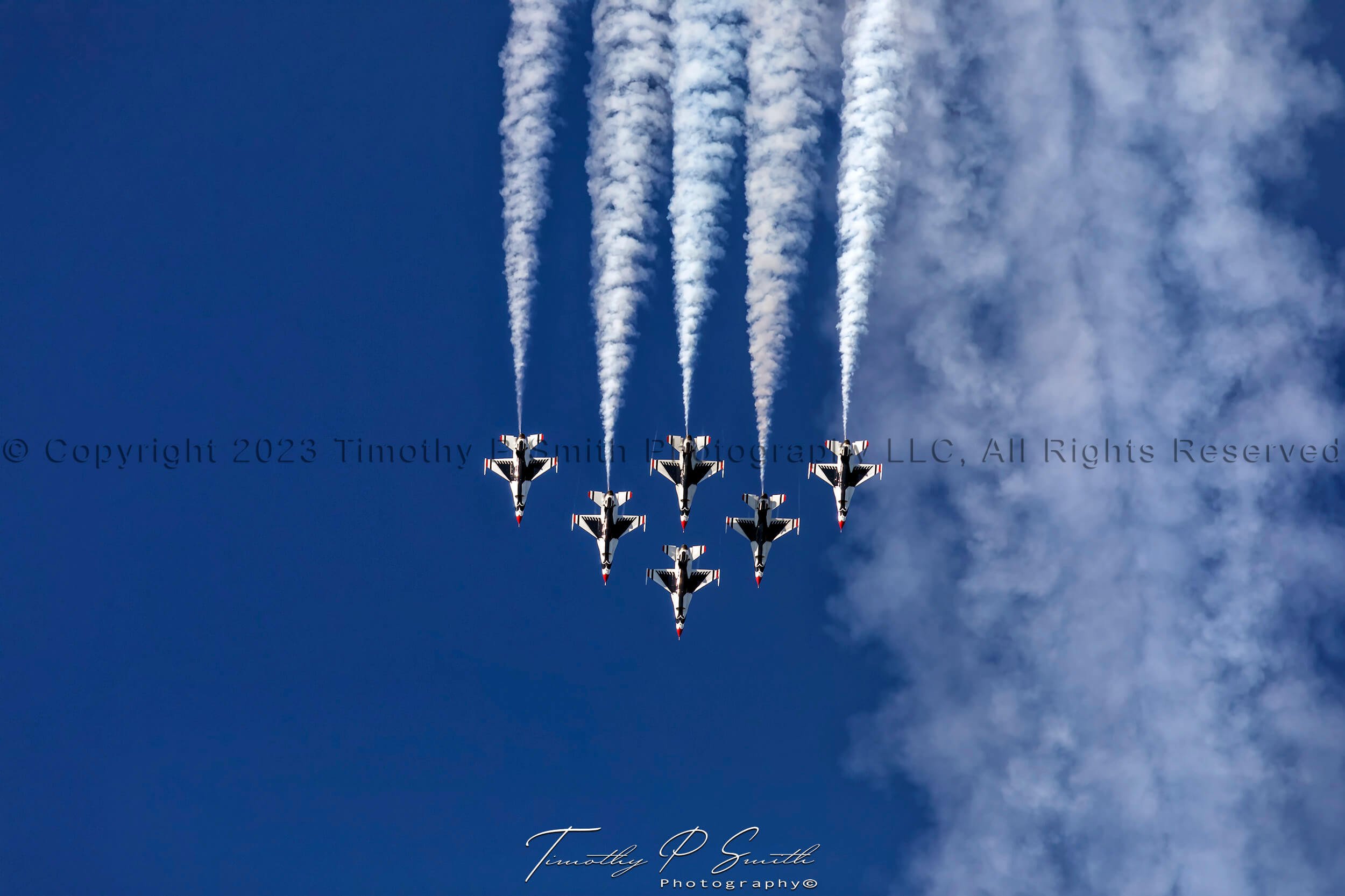
Boundless
A bright blue, clear sky set the US Air Force Thunderbirds scene as they performed the Delta Formation Loop at Wings over Houston in 2019. The Thunderbirds executed this challenging maneuver with military precision, a testament to each pilot's skill and training.
The countless hours and hours of practice and repetition to perform this loop takes months to master. The polished presentation achieved by sheer determination was displayed above Ellington Joint Reserve Base to the delight of this photographer and spectators.
This complicated maneuver takes the total concentration of all six team members working in unison to stay in formation. The placement of each F-16 within Delta is absolutely perfect!
Capturing this image of The Thunderbird Delta Formation loop was a thrill for me. The team's iconic paint scheme against the blue Texas sky was all a photographer could hope for. Watching this maneuver gives a strong feeling that humanity can fulfill any goal or any dream if you work hard and dedicate yourself to it.
This image was taken during Friday’s practice for the Wings Over Houston Airshow on October 18, 2019.
Available only as a Limited Edition. There will be 50 of these images made available.

Normandy Leader
The Commemorative Air Force's Douglas C-47 Skytrain "That's All Brother" role in history is legendary. In Normandy, France, on June 6, 1944, this C-47 led 800 aircraft and dropped over 13,000 American paratroopers to begin the D-day invasion. On this date, "That's All Brother" was flown by the 438th Troop Carrier Group commander, Lt. Col. John Donalson, and Lieutenant Colonel David Daniel.
Lt. Col. Donalson named this C-47 as a statement that the German occupation of Europe would soon end. "That's All Brother" is a veteran of many vital operations such as "Market Garden," "Repulse," and "Varsity."
Following the war, she returned to the United States and was withdrawn from military service and sold as surplus. After languishing in a boneyard in Wisconsin, She was saved and restored to flying conditions. "That's All Brother" once again made history by crossing the Atlantic Ocean to participate in the 2019 D-Day 75th-anniversary ceremonies.
In 2018" That's All Brother" participated in the Wings Over Houston airshow. The Airshow crowd experienced a reenactment with the sights and sounds from the war-torn skies over Europe from the 1940s.
I'm honored to present a visual representation of "That's All Brother" from her service days to this nation. The pyrotechnics sent thick black smoke into the sky. I captured this historic C-47 as she rumbled past the dramatic dark backdrop.
This image was taken during the Wings Over Houston Airshow on Sunday, October 21, 2018.
Available only as a Limited Edition. There will be 50 of these images made available.
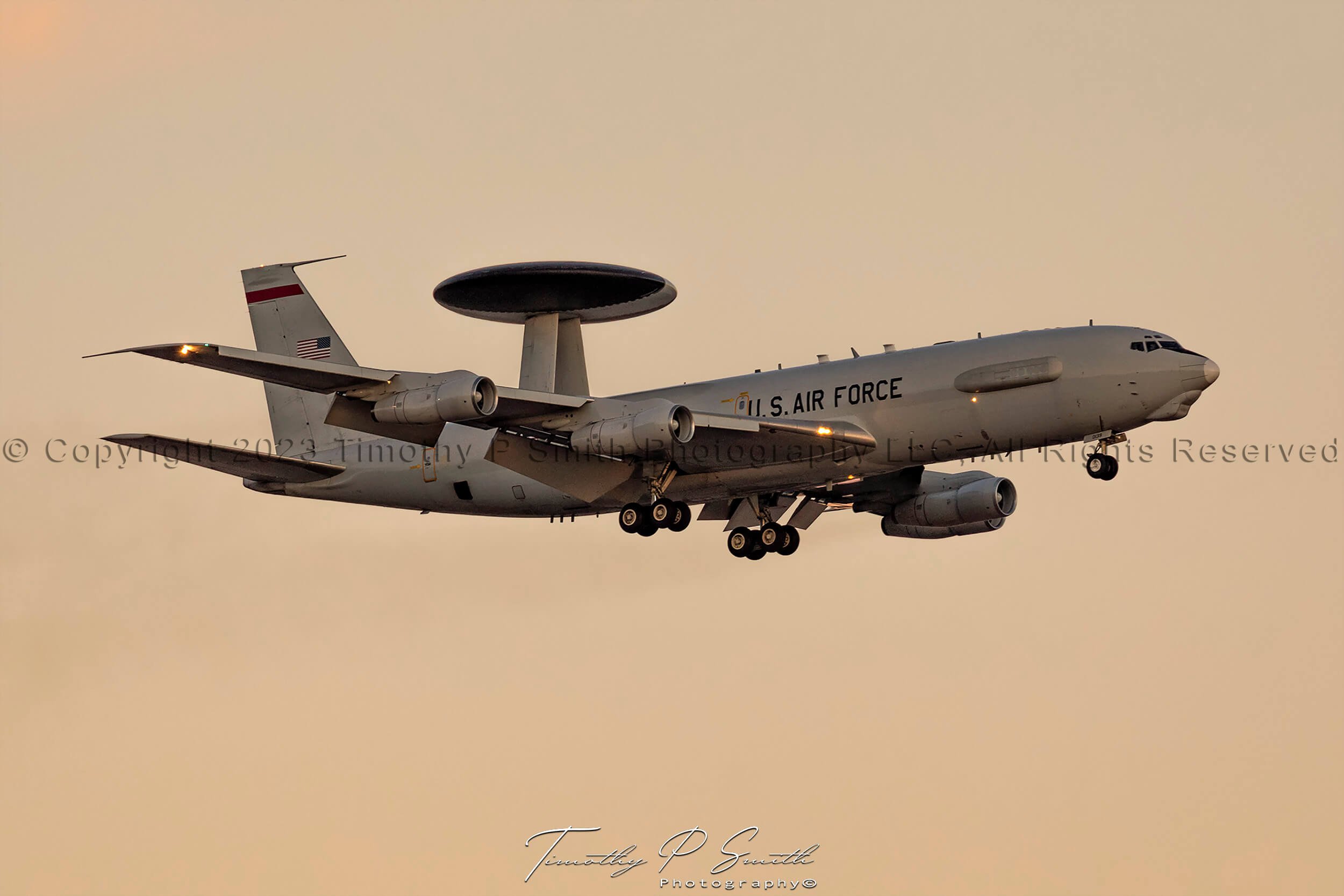
Disco Ball
The United States Air Force E-3 Sentry is a modified Boeing 707 commercial jet airliner from the 1970s. Boeing built only 68 E-3 Sentry from 1977-1992, with only 10 'C' models. Since the USAF's E-3 program began in 1977, the radio callsign "Disco Ball" is appropriate to its period.
This revolving "eye in the sky" provides an accurate, real-time Airspace picture. Its mission is to see beyond the horizon in all conditions and into the battlespace and relay real-time information to friendly forces.
Delivered to the USAF on July 23, 1982, this highly specialized aircraft returns to Nellis AFB after a training exercise during Red Flag 20-1. Capturing this rare aircraft under the desert's setting sun was a challenge in and of itself. Time was fleeting; the day was nearly done, the light was fading. This would be my final opportunity to capture this elusive aircraft. As she approached under the last bit of the evening light, all I could think was, this is it. I waited all afternoon for her return. This bucket list classic did not disappoint.
This image was taken during Red Flag 20-1 Nellis Air Force Base, Nevada, on February 14, 2020.
Available only as a Limited Edition. There will be 50 of these images made available.
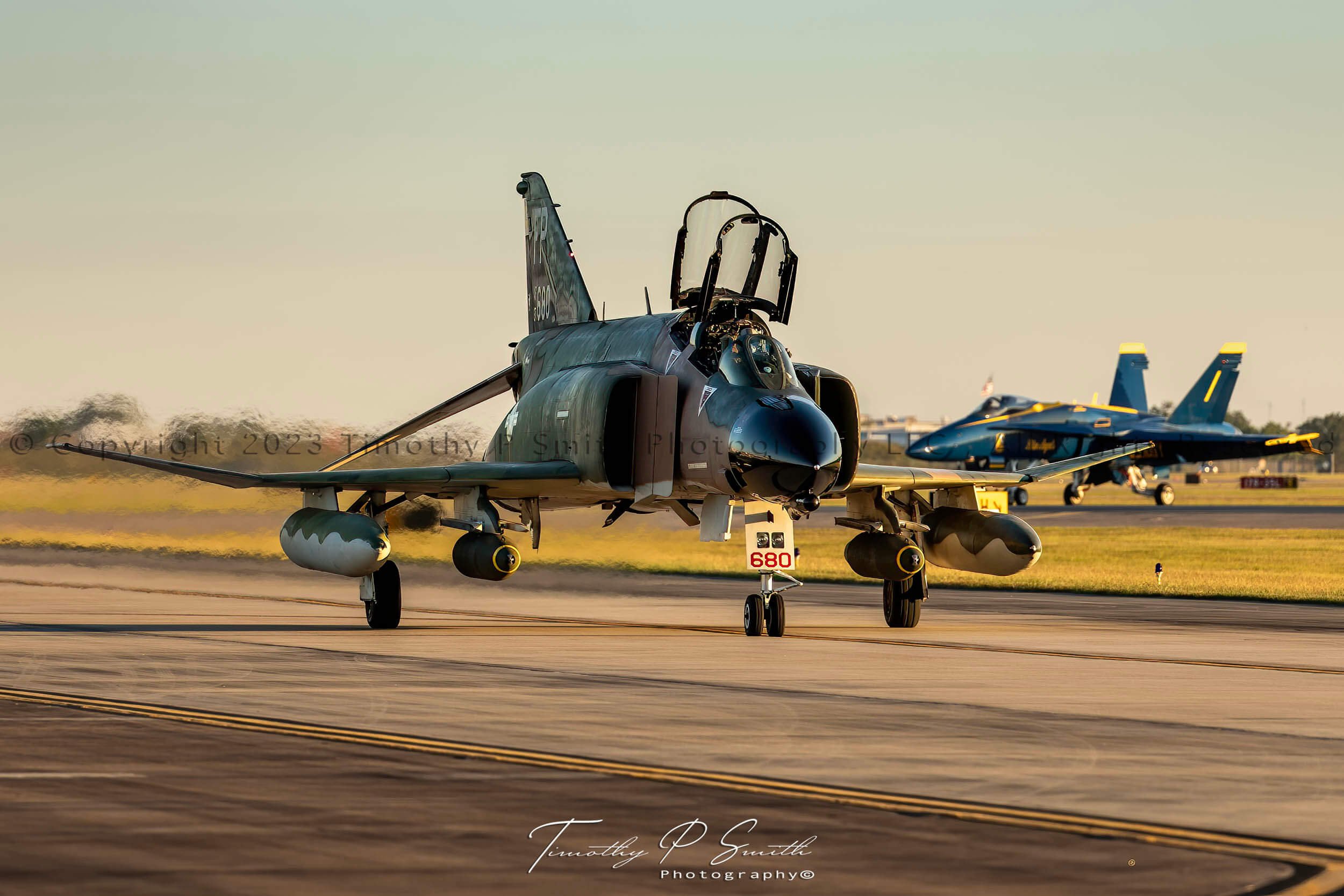
Phantom Dawn
The F-4 Phantom II was built in the 1960s by the McDonnell Douglas aerospace manufacturing corporation. The Phantom is a two-seat, twin-engine, muti-role fighter developed for the United States Navy. Proving to be a versatile design, the F-4 was also ordered by the Air force and Marine Corps respectfully. F-4s operated with 11 other nations as well as the United States. The F-4 developed a reputation as a rugged, technologically advanced, remarkably stable multi-role fighter/bomber. The Phantom would establish itself as the pre-eminent fighter of its time and forge an equally successful combat career.
The Collings Foundation's F-4D Phantom II is the only flightworthy example in North America. Listed on the US civil registry as N749CF, the 1965-built F-4D Phantom II previously flew with the USAF 65-0749. Her paint scheme represents a Phantom II flown by Col. Robin Olds during Operation Bolo in the Vietnam War.
As dawn broke Sunday morning, the weather cleared from Saturday's heavy rain and overcast skies. I began packing equipment and headed towards the Wings Over Houston airshow gates. I noticed a young man standing in the bed of a pickup truck, looking toward the airfield. I asked him, "What's going on"? His face lit up with joy as he pointed toward Ellington Field. He said with a huge smile, "The Collings Foundation is gonna Fly the Phantom!" It is this kind of excitement this aircraft generates with aviation enthusiasts today.
The F-4 taxis onto Ellington Field, ready to take to the skies again. Her massive shape moving straight toward me, was a scene from a 1960s movie. The heat and jet exhaust produced by this beast was tremendous. With both Canopies open, the Mighty Phantom taxis by on her way to runway 35 Left. Capturing this aviation icon was a memorable moment I will not soon forget.
This image was taken before the Wings Over Houston Airshow started on Sunday, October 21, 2018.
Available only as a Limited Edition. There will be 75 of these images made available.
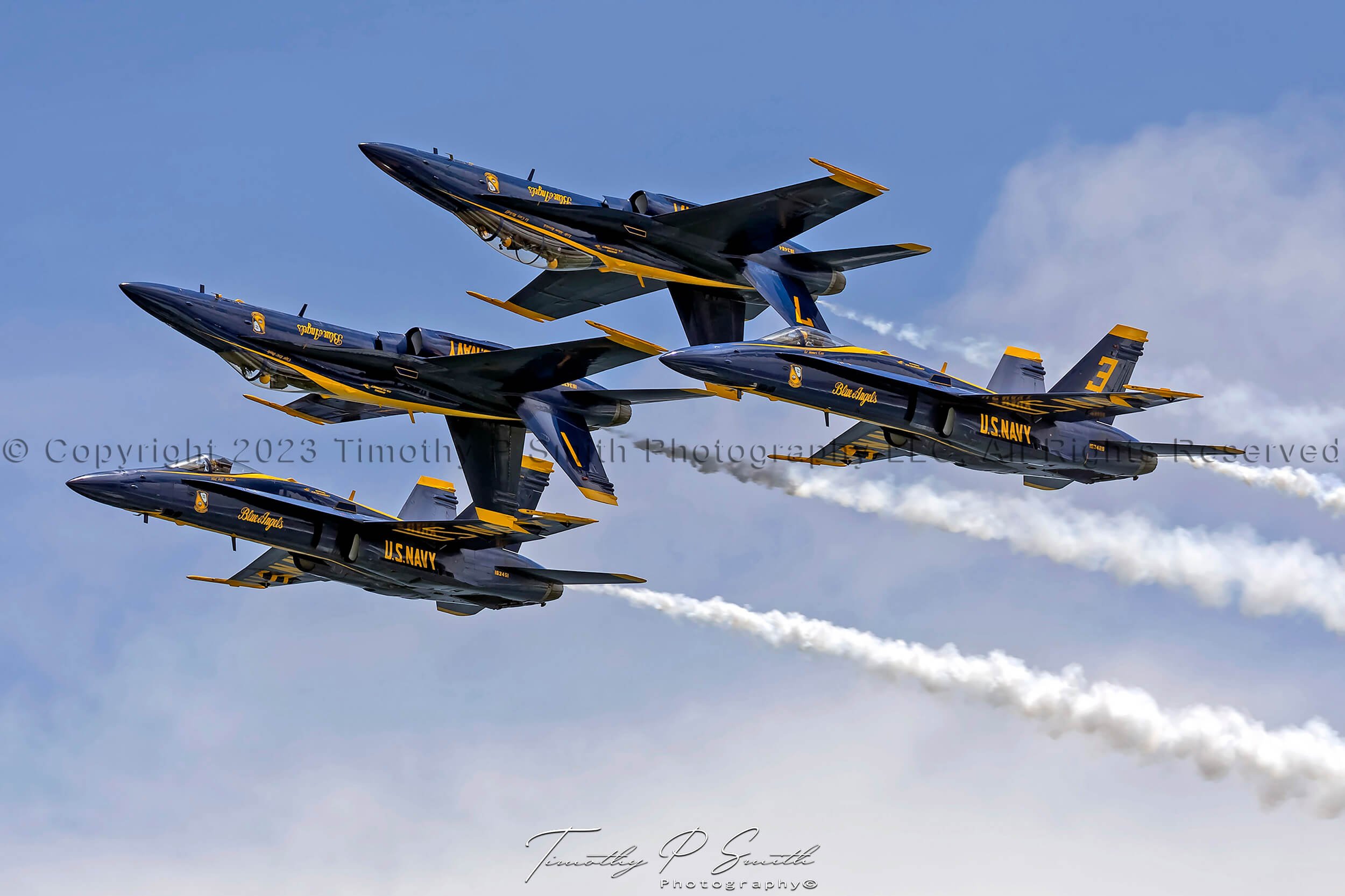
The Blue Angels Double Farewell
The Blue Angels Double Farvel, meaning double farewell in French, is a thrilling maneuver to observe. Blue Angel #1, "Boss," and Blue Angel #4, "the slot" position roll inverted simultaneously approximately one nautical mile before entering the airshow box. Blue Angel #2, Left Wing, and Blue Angel #3, Right Wing, remain upright.
No, later than one nautical mile past center point, Blue Angel #1 and Blue Angel #4 simultaneously roll upright into a climb for the break. The break out of the Diamond is as dynamic as the maneuver itself. The coordination and timing to properly execute this maneuver are very complex and layered with details. Nevertheless, this formation provides a clear view of the jet's topside and bottom side with remarkable fluidity.
The Double Farvel is incredible to watch and, according to some pilots, is one of the more difficult maneuvers for the Diamond pilots to perfect. It is a fan favorite and a staple of the squadron's demonstration. True to the Blue Angel mantra to pursue perfection and continually make the presentation its best, The Blue Angel Double Farvel lends an opportunity to witness the pilots' remarkable talents.
The demonstration was no small task on Thursday, July 11, 2019, at Blue Angels beach week airshow. With Hurricane Barry's waves and wind building just off Pensacola Beach's shore, the perfect execution of this maneuver was even more of a challenge.
The Blue Angels Diamond formation approached from the west along the shores of Pensacola Beach. Through the camera's viewfinder, I could see the formation closing on my position just east of the Pensacola Pier. You could see the pilots battle the crosswinds coming onshore from The Gulf. I admired the skill of holding a formation like the Double Farvel in the incoming storm's building winds. Boss Doyle and the Diamond did not disappoint.
This image was taken during Blue Angel Pensacola Beach week on Thursday, July 11, 2019.
Available only as a Limited Edition. There will be 75 of these images made available.
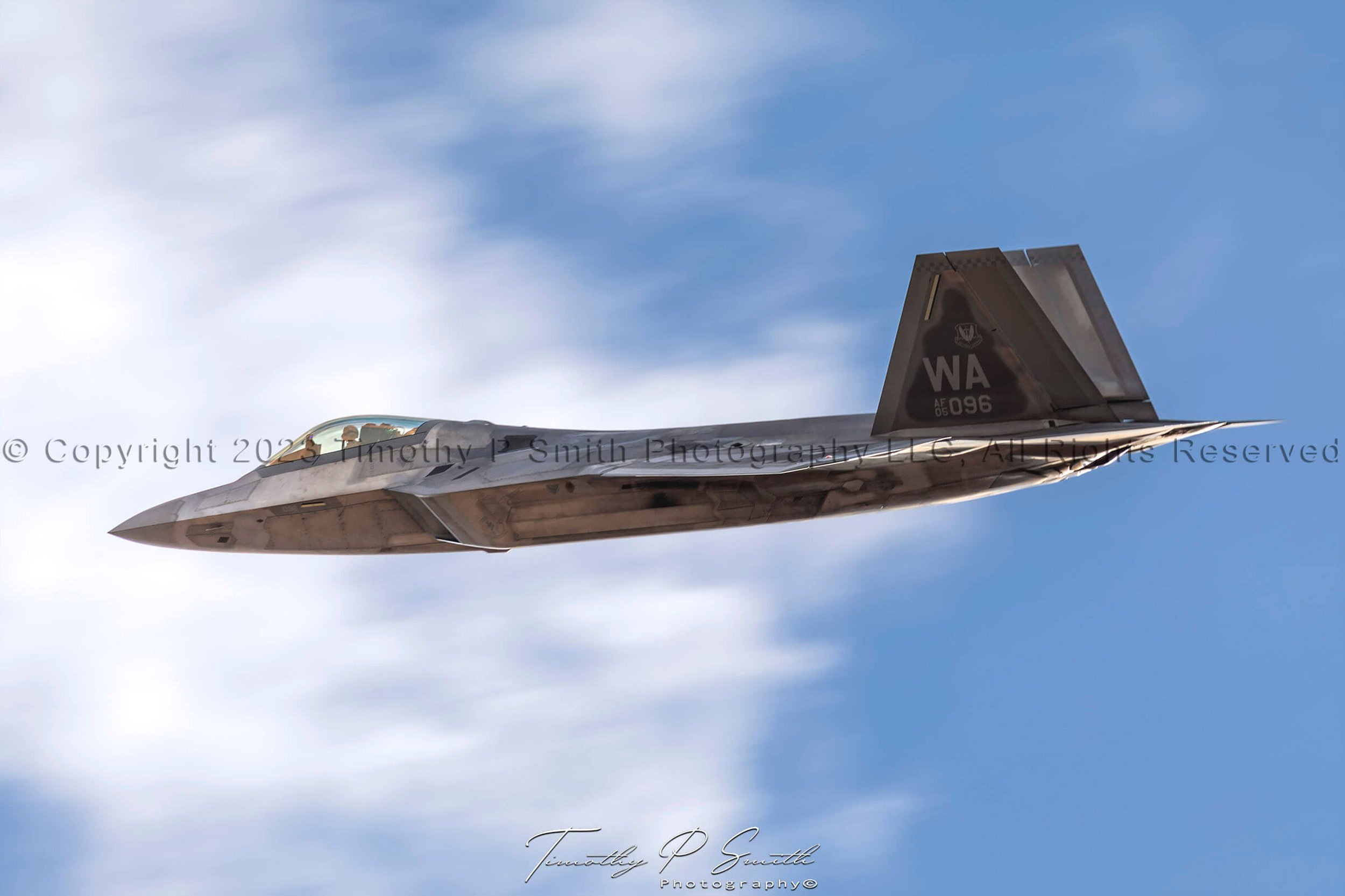
Morning Hunter
The F-22 Raptor is an all-weather, single-seat, twin-engine stealth fighter developed for the United States Air Force. In 1981, the USAF identified a need to replace the F-15C by the mid-1990s. Lockheed Martin designed this 5th generation fighter to be that replacement. The original USAF order was for 750 F-22; however, the program was cut short at just 187 operational airframes.
The Air Force had found a fighter in this "Bird of Prey" that would become a critical figure in the nation's air defense. The aircraft's capabilities were tested and proven during an exercise in Alaska in June 2006. The F-22 achieved a kill ratio of 221-0 in simulated combat from June 2006 through December 2007. Twelve F-22s downed 108 adversaries with zero losses.
In February 2020, I had the opportunity to visit Nellis Air Force Base for Exercise Red Flag 20-1. As the morning of the 10th began, I was eager to start photographing military aviation units as they practiced their skills over the Nevada desert. However, it was not long before the unmistakable sounds of the jet engines filled the air. Nellis was ready to launch; my camera and I were eagerly waiting.
At 9:30 am, a layer of broken cloud cover filtered the natural desert light. I wanted to use the unique qualities of this light in a particular area of the sky. I readied my camera, hoping to capture the Raptor as it transitioned into this area. I attempted a low shutter speed shot to capture the Raptor after take-off. I wanted to give the aircraft motion within the frame as it rocketed past my position. I was most pleased with the result after completing this image's post-processing edits.
This photo of the Weapon School's Raptor departing Nellis for the training range is one of my favorites from the Red Flag trip. I hope you enjoy this image.
This image was taken during Red Flag 20-1 Nellis Air Force Base, Nevada, on February 10, 2020.
Available only as a Limited Edition. There will be 25 of these images made available.

Ready Now!
The United States Air Force demo team, the Thunderbirds, aircraft of choice is the F-16 Fighting Falcon. A compact, multi-role, single-seat fighter developed in the 1970s. It is a powerful yet agile platform that has proven itself in air-to-air combat and air-to-surface attack.
For the Low Bomb Burst, The Thunderbirds will approach head-on in front of the crowd. In this maneuver, the five jets used create a dynamic burst effect. The Fighting Falcons enter the airspace in a tight formation. As close as 18" apart, with an approximate airspeed of 500 mph to execute this visually stunning maneuver.
As the aircraft approach center point, anticipation builds as they prepare for the break. Then, finally, the Boss will call, "Smoke on. Ready, Now." This remarkable maneuver resembles a firecracker exploding with the burst of color from The Thunderbirds' red, white, and blue paint scheme.
The opportunity to photograph one of the elite demo teams of the United States never fails to cause excitement. This image was a unique perspective of this maneuver due to my position off the field's centerline. The lighting, combined with the heavy cloud cover, made this an even more significant challenge to show the details of the aircraft and its paint scheme. This image never fails to take me back to this moment. I can hear Boss on my radio calling, "Ready Now."
This image was taken during the 2018 Wings Over Houston on Sunday, October 20, 2019.
Available only as a Limited Edition. There will be 75 of these images made available.

American Gunfighter
The North American Aviation P-51 Mustang, an iconic American aircraft celebrated for its long-range capabilities and versatile role as a fighter and fighter-bomber, has left an enduring legacy in aviation history. Conceived in April 1940, the design of the Mustang was led by James Kindelberger and his team at North American Aviation in response to a request from the British Purchasing Commission. Initially tasked with manufacturing Curtiss P-40 fighters for the Royal Air Force, North American Aviation proposed a groundbreaking shift by advocating the creation of a new, modern, and advanced fighter instead of replicating an existing model. This innovative approach resulted in the birth of the P-51 Mustang, a symbol of excellence and accomplishment in aviation.
The specific P-51 Mustang known as "Gunfighter" was constructed in March 1945 at North American Aviation's California plant and promptly shipped to England. Adorning the colors and markings of the 343rd fighter squadron, part of the renowned "Mighty Eighth" Air Force, this aircraft played a crucial role in the European theater. After the cessation of hostilities in Europe, "Gunfighter" returned to the United States. 1947, she served with Air National Guard units in Wyoming, New Mexico, Illinois, and Kentucky before being declared surplus. By 1956, "Gunfighter" found a new home in the civilian market.
P-51 Mustangs hold a special place in the hearts of aviation enthusiasts, and "Gunfighter" is no exception. The photograph captures the distinctive features of this sky warrior, showcasing the aircraft's unique characteristics and unmistakable identity as a Mustang. The powerful four-bladed propeller, slicing through the air over New Orleans, adds to the visual spectacle, emphasizing this iconic warbird's enduring beauty and historical significance.
This image of “Gunfighter” was taken during the New Orleans Lakefront Air Expo on Sunday, October 14, 2018.
“American Gunfighter” will be available exclusively as a Limited Edition, with only 50 copies made available.

Light up the Sky
The F-35A, a variant of the renowned F-35 Lightning II family, is a versatile and cutting-edge fifth-generation stealth fighter jet in the United States Air Force’s arsenal. Designed to excel in both air-to-air and air-to-ground missions, the F-35A integrates advanced stealth technology, superior sensor capabilities, and a state-of-the-art avionics system. This single-seat, single-engine aircraft boasts remarkable agility and exceptional situational awareness, providing pilots with an unparalleled view of the battlespace. Its seamless system integration and cross-force interoperability make the F-35A a pinnacle of modern military aviation—ensuring air dominance and mission success in today’s rapidly evolving threat landscape.
In 2019, the United States Air Force announced that the F-35 Demonstration Team would perform at air shows—marking the first time aviation enthusiasts could witness the jet’s capabilities firsthand.
During his tour as demo pilot, Captain Andrew “Dojo” Olson and the F-35 Demo Team consistently left crowds breathless with displays of raw aerial power. That Friday in Houston was no exception. “Dojo” presented his F-35 Lightning II for the photo pass—cloaked in wingtip vortices and a shimmering double cone as the jet tore low across Ellington Field.
This image was taken during Friday’s practice for the Wings Over Houston, October 18, 2019.
“Light up the Sky” will be available exclusively as a Limited Edition, with only 25 copies made available.

Delta Rising
In 2018, Wings Over Houston—one of the premier air shows in the United States—was headlined by the world-famous U.S. Navy Blue Angels. That season’s Blue Angels Boss and Number One was Commander Eric Doyle, a League City, Texas native, undoubtedly eager to return to his home turf with the team for the weekend’s performance.
The six F/A-18C Hornets joined up behind the crowd in their iconic formation known as “The Delta.” As they approached Ellington Field, they prepared to execute one of their signature maneuvers: the “Delta Roll.” Graceful and synchronized, this maneuver perfectly showcases the elite skill of the Blue Angels aviators. Maintaining just 18 inches of separation while rolling in perfect harmony is a jaw-dropping display of precision flying.
The Delta Roll also highlights the agility of the Legacy Hornets, each jet holding tight formation as they soared above the airfield.
Capturing this exact moment as these masterful aviators performed the maneuver was pure magic. The Delta Roll is breathtaking to witness and remarkably difficult to photograph—especially with all six jets in frame. It’s a joy to share this image, a tribute to the U.S. Navy and Marine Corps at their finest.
This image was taken during Wings Over Houston on Sunday, October 21, 2018.
“Delta Rising” will be available exclusively as a Limited Edition, with only 50 prints released.
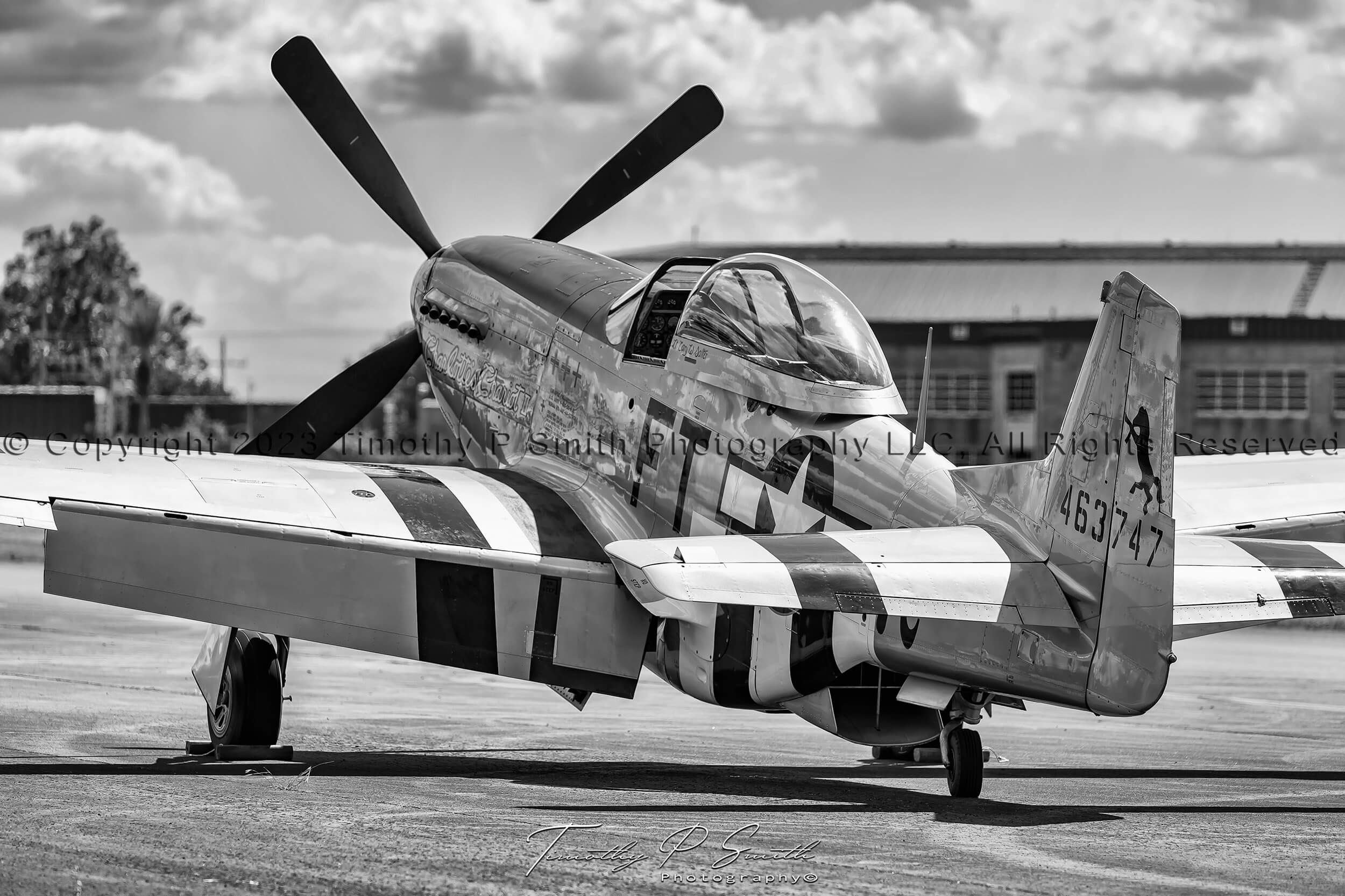
“Charlotte’s Chariot II”
Charlotte's Chariot II is a North American P-51D Mustang owned by the Southern Heritage Air Foundation. Lt. Col. Cary Salter named this aircraft "Charlotte's Chariot II" in honor of his beloved wife, Charlotte.
Its current paint scheme pays tribute to Lt. Col. Salter’s storied service. His aviation career began in June 1942 when he enlisted in the Aviation Cadet Training Program. After completing his training in October 1944, he was deployed to Europe. As a member of the 354th Fighter Group, he flew over 50 combat missions and was credited with 2.5 aerial victories. For his service to this country, Lt. Col. Salter was awarded the Silver Star and the Air Medal with eight oak leaf clusters.
I photographed Charlotte's Chariot II at the New Orleans World War II Air, Sea & Land Festival in 2018, and was immediately captivated. Some aircraft leave a lasting impression—and after completing the post-processing, this image did just that. It offers a glimpse into yesteryear, where courage and craftsmanship soared side by side.
This image was taken during the New Orleans Lakefront Air Expo on Sunday, October 14, 2018.
“Charlotte's Chariot II” will be available exclusively as a Limited Edition, with only 50 prints released.
Order Your Limited Edition “Charlotte’s Chariot II” Print Today

Viking Invasion
The Boeing EA-18G Growler is a US Navy airborne electronic attack platform. The primary mission of the Growler is to suppress enemy air defense and communications systems. This Aircraft can achieve its mission through both destructive or disruptive means. By neutralizing the enemy’s ability to detect friendly forces, the Growler’s role is integral to a military operation. The Growlers are smart and deadly with their combined electronic attack and strike capability.
Boeing delivered the first production airframe to the US Navy in 2007. The Growler replaced the EA-6B Prowler, which has been in service since 1971. The Growler is a variant of the combat-proven F/A-18E/F platform. The Growler operates from either the Navy's carriers or land bases worldwide.
In October 2019, I was thrilled that a Growler would participate in the Wings Over Houston Airshow at Ellington Field. This Growler is assigned to the Fleet Replacement Squadron VAQ-129, known as the “Vikings,” based at Naval Air Station Whidbey Island, Washington. Whidbey Island is the proud home of the Electronic Attack Program for the US Navy.
As the Growler took to the skies over Ellington Field, I eagerly anticipated its performance. This would be my first experience with a Growler’s demonstration at an airshow. As the E/A-18G rounded the spectator area, the aircraft whipped into a 70-degree banked turn around the crowd. With the Growler’s first pass of its demonstration, the Viking flight crew made clear this is an impressive aircraft. The Growler demonstrates this banking high-speed pass in this image, blanketing the wings with a vapor shroud.
This image was taken during Wings Over Houston on Sunday, October 19, 2019.
“Viking Invasion” will be available exclusively as a Limited Edition with only 25 copies made available.
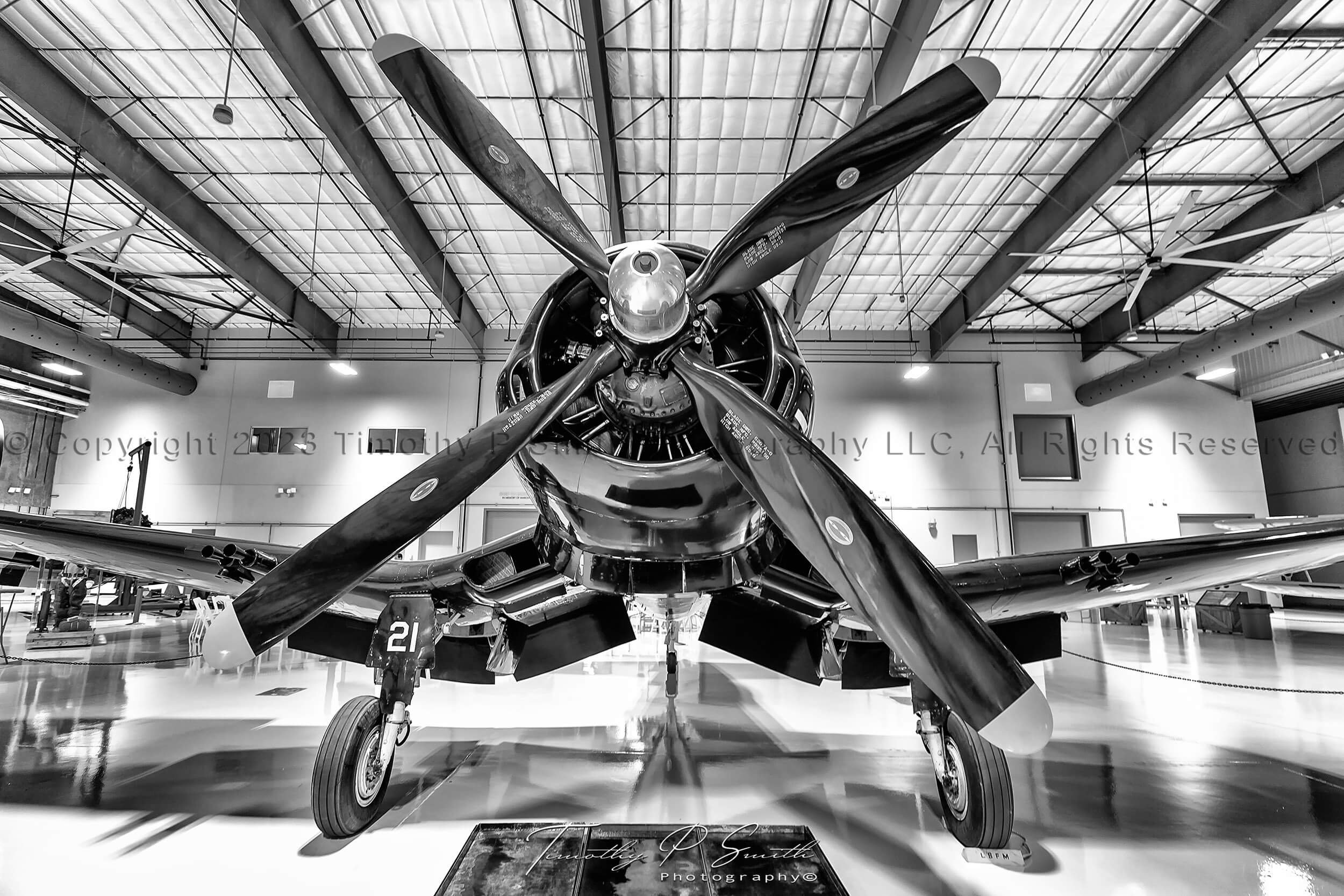
The Night Fighters Lair
The Lone Star Flight Museum’s Chance Vought F4U-5N Corsair “Annie-Mo” is a night fighter version of this timeless warbird. The Chance Vought Aircraft Corporation contracted with the US Navy to design a single prototype fighter aircraft in June 1938. Vought engineers selected the new 2,000-horsepower Pratt & Whitney R2800 engine for the project that would become the Corsair. When designing the airframe around this powerful radial engine with a 14-foot diameter propeller, careful considerations were made to ensure safe ground clearance met for carrier landing requirements. The final design gave the Corsair its distinctive inverted gull-wing shape. The landing gear was positioned at the lowest point on the wing to make it more compact and robust. The Corsair would become the first American fighter to exceed 400 mph and served extensively with the US Navy and Marines during WWII and the Korean War. The Corsair became known as “Whistling Death” and was the first piston engine aircraft to down a MiG-15 in air-to-air combat. The reliability of this aircraft was legendary and beloved by such pilots who flew her. The Corsair made its maiden flight on 29 May 1940 and was in production until December 1952. It is arguably among the US Navy's and Marine Corps’ finest fighters.
The Lone Star Museum in Houston, Texas, provides a perfect backdrop for this star of aviation history. Photographing this particular Corsair was challenging due to its lighting and surroundings. This image of “Annie-Mo” presents everything you expect a strong and gritty Corsair to be. The shadowing and reflections add to the mystic of this beautifully kept warbird. I am very pleased to share this star of the museum with you. It was a joy to capture this absolute legend in aviation history that is still airworthy. If you have the chance to see her fly, you should not miss it.
“The Night Fighters Lair” will be available exclusively as a Limited Edition, with only 25 copies made available.

Vapor Breakout
Home for the Blue Angels is Forrest Sherman Field, NAS Pensacola, Florida. In July 2019, the Pensacola Beach Week Airshow provided the Team a chance to perform for their hometown. For the Blue Angel faithful, this annual pilgrimage to the Gulf Coast to view their favorite team is a must. Inside the squadron ranks, Beach Week is highly anticipated within their season. For this event, thousands pack the beaches and the waterways around Pensacola. Hurricane Barry had other plans!
On this day, as practice time neared, Barry's outer bands threatened Pensacola Beach. It was questionable if the Blues would be able to proceed with the practice due to the 17-plus knot winds. As the practice began, a brief rain shower soaked the crowd, but it did not drive the die-hard fans away. As the Team battled through inclement weather, the skies began to clear. With the Blues driving away Barry, clearer skies and high humidity were left behind. The yield was some spectacular jet vapor.
The team started the Barrel Roll break over the Gulf of Mexico’s churning waters. After the diamond completed a flawless loop, Boss Doyle led the team down the shoreline to the Airshow center. I steadied myself, took a deep breath, and got ready for the big moment: The break. I chose one target as all four jets departed the diamond in multiple directions. In this image, Blue Angel #3, LT James Cox, Left-Wing, executes a hard break as he departs the diamond formation.
This image was taken during Blue Angel Pensacola Beach week on Thursday, July 11, 2019.
“Vapor Break out” will be available exclusively as a Limited Edition. , with only 60 copies made available.
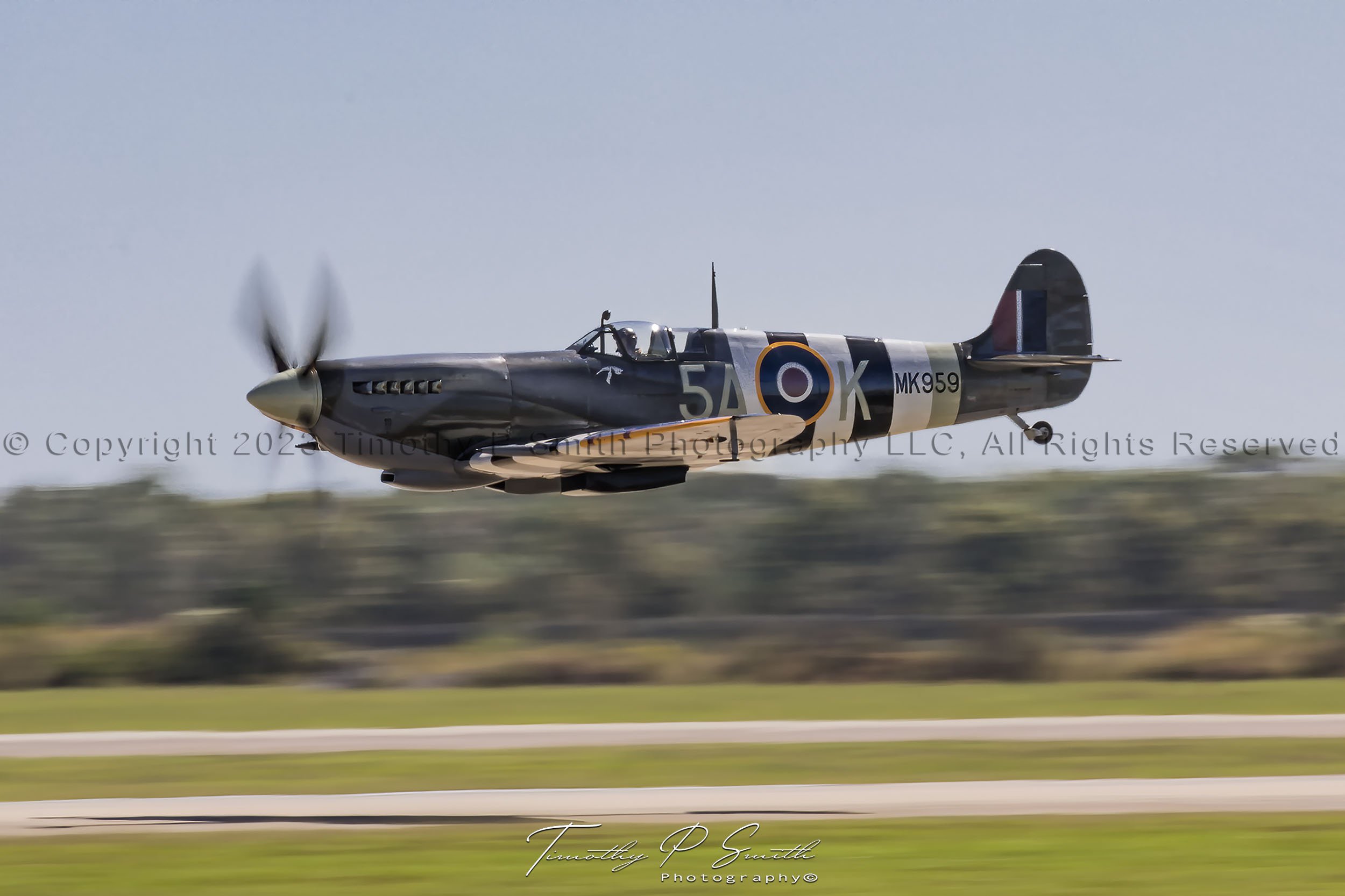
Merlin Magic
The Supermarine Spitfire is a legend within the aviation community. This iconic fighter holds a firm place in history, having fought in every theater from Europe to the Pacific. The Spitfire was the only British fighter manufactured before 1939 that remained in production beyond 1945.
The Texas Flying Legends Museum in Houston, Texas, owns this particular Spitfire—an LF Mk.IXc with serial number MK959. A true combat veteran, MK959 originally served with the Royal Air Force’s 302 Squadron during the Battle of Britain. She continued flying with the 302 until May 1944, when she was transferred to 329 Squadron—staffed by French pilots from the former French Air Force until the unit was absorbed into the RAF.
MK959 flew her first sortie with the new squadron over the Normandy beachheads on June 17, 1944. Later, on August 30, she was transferred to 165 Squadron and continued flying missions over Europe until the war’s end. Today, she proudly wears the same codes (5A-K) and invasion stripes from her 329 Squadron service.
I photographed MK959 at the 2016 Wings Over Houston Airshow, and she did not disappoint. The show began with a formation of classic warbirds; then, her pilot broke from formation and pointed the nose toward Ellington Field. Her Rolls-Royce Merlin engine thundered as MK959 skimmed mere feet above the runway—a pass that honored both pilot and aircraft. “Hauling the mail,” as they say, and this photo captured it all.
This image was taken on Sunday, October 22, 2016, during Wings Over Houston.
“Merlin Magic” will be available exclusively as a Limited Edition, with only 75 prints released.
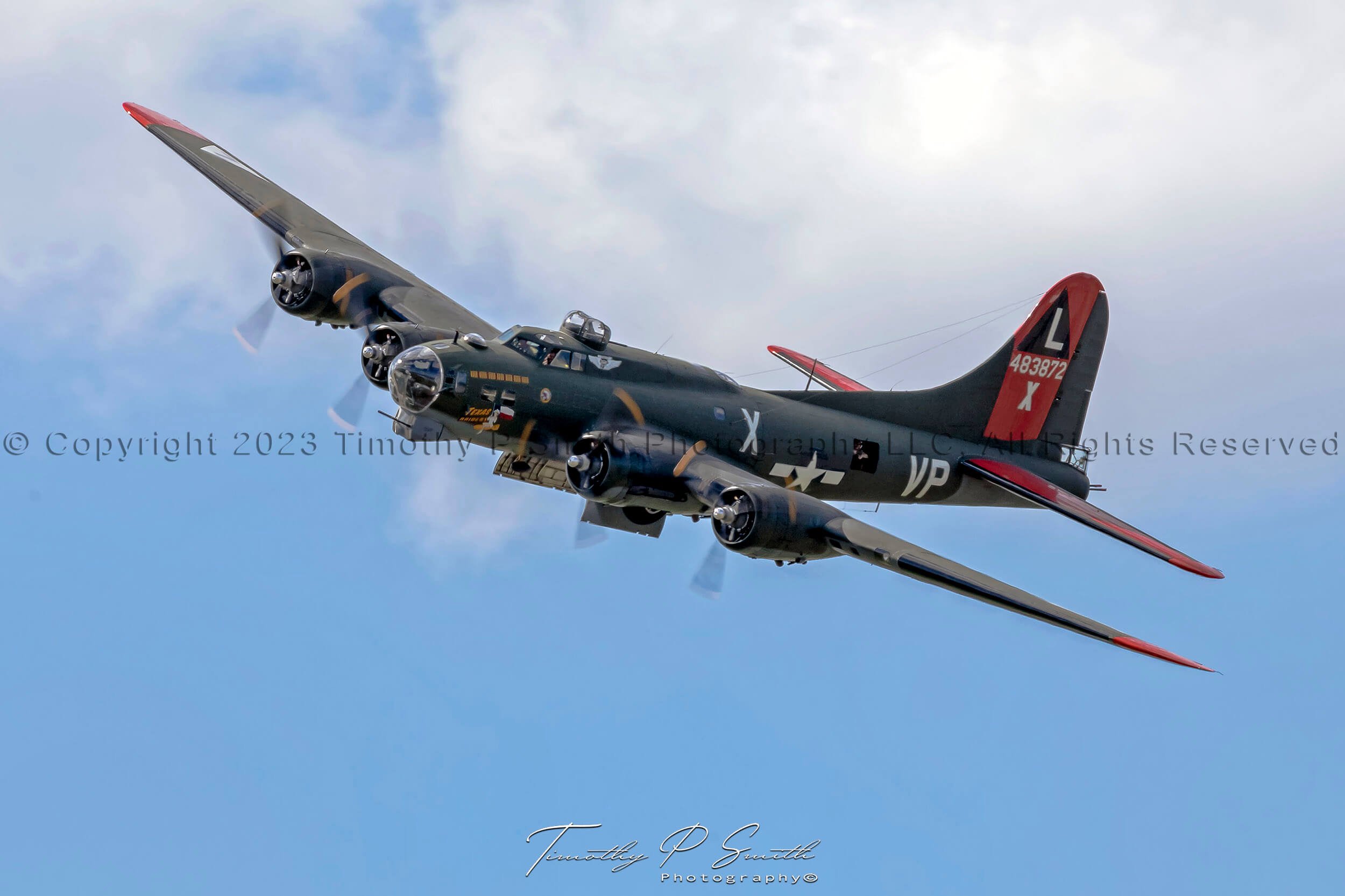
Don't Mess with Texas Raiders
This Boeing B-17G wears the colors and markings of the U.S. Army Air Corps 8th Air Force, 1st Air Division, 533rd Bombardment Squadron, and the 381st Bombardment Group. “Texas Raiders” is one of the most historically accurate and airworthy Flying Fortresses in existence—and one of only eight B-17s still flying today. She stands as a tribute to all who served aboard this graceful, yet formidable, warbird.
The story of the B-17’s development mirrors that of America itself—constantly adapting and evolving into the legend it would become. As one of the most potent symbols of American airpower, the B-17’s legacy spans generations.
Developed in the 1930s, this four-engined heavy bomber made its debut under the watchful eye of the U.S. Army Air Corps. In July 1935, Seattle Times reporter Richard Williams famously described it as a "15-ton Flying Fortress." Boeing immediately recognized the brilliance of the name—an identity that would carry the aircraft into history.
The B-17 saw extensive service in both the Pacific and European theaters, but it was in Europe where it cemented its legend. With a bomb load of up to 8,000 pounds and a range of 2,800 miles, the B-17 could strike deep into enemy territory. Flying in massive V-formations, their combined firepower offered a measure of protection from relentless German fighter attacks.
Yet those missions were some of the most dangerous of the war. Crews faced staggering losses, and the B-17 earned its reputation for toughness by often limping home with damage that would ground lesser aircraft. Of the approximately 1.5 million tons of bombs dropped in Europe, the Fortress was responsible for 640,000 tons—more than one-third.
On October 10, 2018, “Texas Raiders” visited the New Orleans Lakefront Airport as part of the Air, Land, and Sea Expo. She roared into the skies and delivered a thunderous pass with bomb bay doors open, reminding all who watched of the legacy she carries.
This image was taken during the New Orleans Lakefront Air Expo on Sunday, October 14, 2018.
“Don’t Mess with Texas Raiders” will be available exclusively as a Limited Edition, with only 50 copies available.
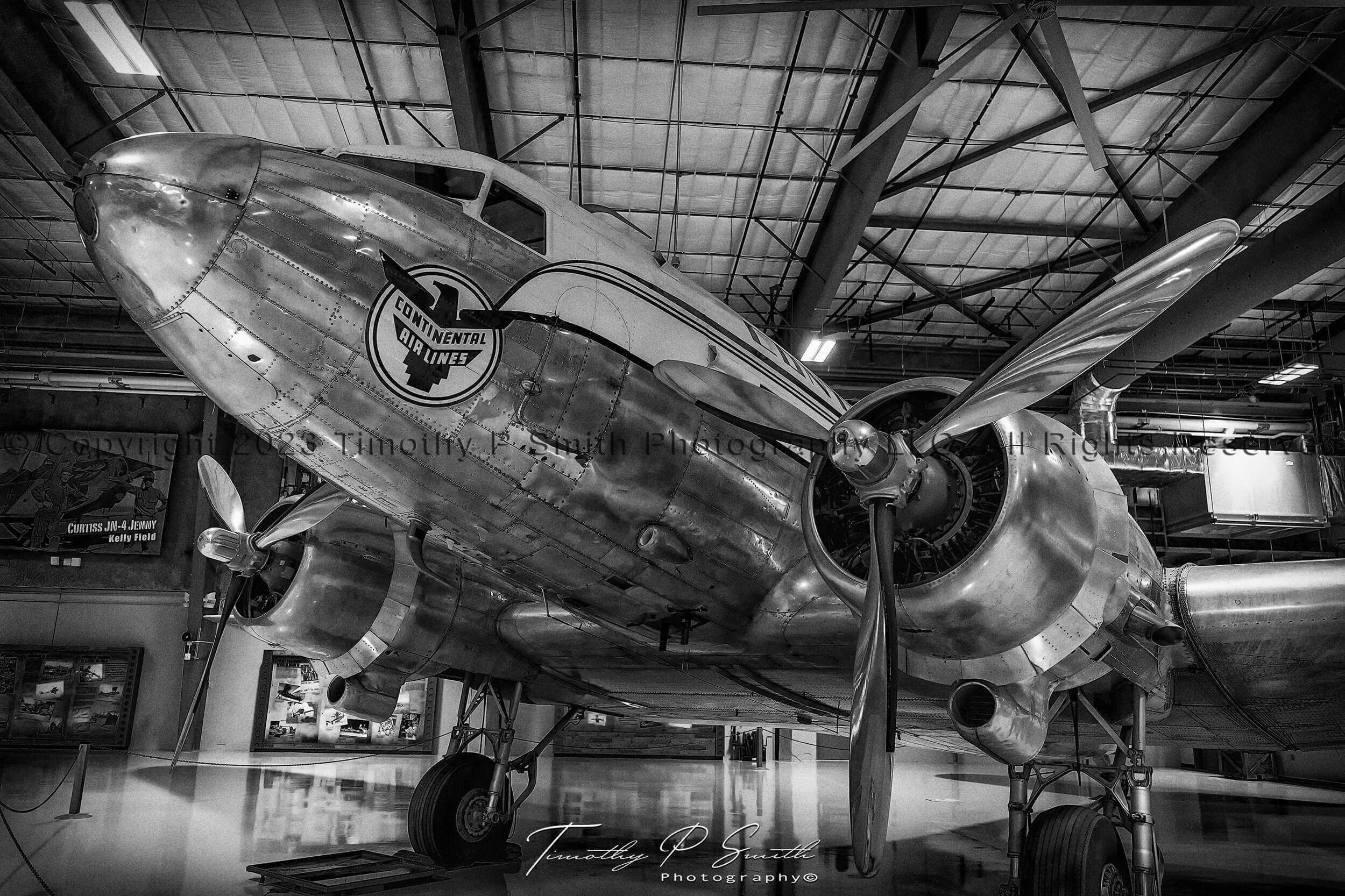
Continental First DC-3 Mark 2
Air travel in the 1930s was both costly and hazardous for the average person. In 1935, the Douglas Aircraft Company set out to revolutionize commercial aviation with the DC-3—perhaps the most innovative airliner design in aviation history. Their goal: to create an aircraft that offered safer, more comfortable, and more efficient air travel for a growing consumer base.
The Douglas DC-3 dramatically shifted passenger expectations and set a new industry standard for cost, convenience, and destination availability. It pioneered countless air routes across the United States, offering transcontinental service in just 18 hours, at an average ticket price of $300. With seating for 21 to 32 passengers, its aerodynamic design brought better fuel efficiency and longer range. It was also the first airliner capable of profitably carrying passengers, ushering in a new era of travel.
The DC-3 featured groundbreaking innovations like retractable flaps for slower landing speeds and shorter take-offs, allowing it to use smaller airstrips. Many of its design principles remain present in modern aircraft today.
The Lone Star Flight Museum’s DC-3 rolled off the Douglas assembly line in 1940. It served with American Airlines and later Trans-Texas Airways, which eventually became part of Continental Airlines. In 2004, when Gordon Bethune—CEO of Continental Airlines—was inducted into the Texas Aviation Hall of Fame, Continental donated this aircraft to the museum.
The museum’s hangar sets a perfect stage for this aviation icon. With carefully positioned lighting and a vintage backdrop, the DC-3’s bare aluminum skin and classic paint scheme transport visitors back to the 1930s. Reflections shimmer across its timeless curves, evoking both nostalgia and wonder.
Continental First DC-3 Mark lI will be available exclusively as a Limited Edition, with only 50 copies made available.



















